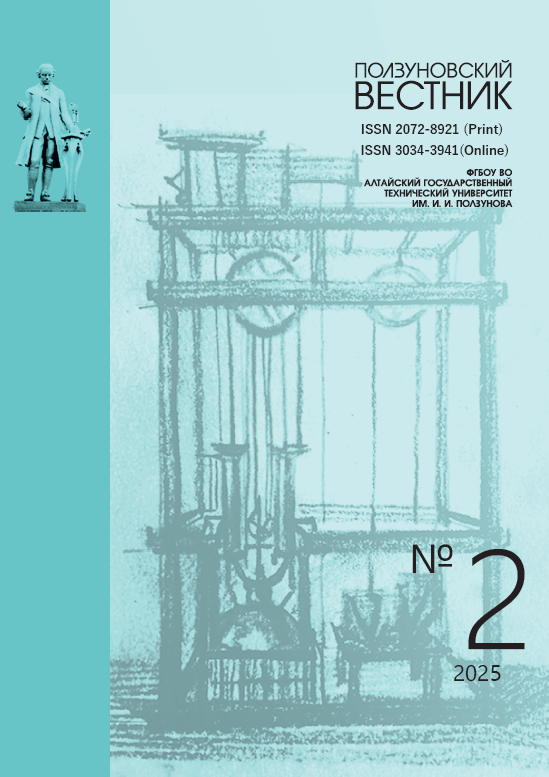USE OF WHEAT HUSK AS A NATURAL SORPTION MATERIAL FOR OIL SPILL RESPONSE
LGVFAO
DOI:
https://doi.org/10.25712/ASTU.2072-8921.2025.02.29Abstract
Oil extraction and refining are accompanied by significant environmental risks, including oil spills that lead to pollution of water bodies and soil. The relevance of the research is determined by the need to develop environmentally safe and cost-effective methods of oil pollution elimination. The aim of the work was to study the effectiveness of wheat husk as a sorption material for the elimination of spilled oil. To improve the sorption properties, the natural polymer was modified with 1 % sulphuric acid solution.
Sorption characteristics of native and modified samples of wheat husk were studied. It was found that treatment with sulfuric acid increases the specific surface area of the material from 5.8±2.8 to 8.0±1.5 m²/g and pore volume from 1.52±0.1 to 2.76±0.1 cm³/g. The sorption capacity of modified wheat husk was 6.35 g/g, which was 20 % higher than that of native samples (5.23 g/g). In removing oil film from the water surface, the modified SW showed an efficiency of 99.31 %, whereas the native showed an efficiency of 96.96 %.
Experiments on phytotoxicity showed that water treated with modified wheat husk had a toxicity index of 0.1, which is lower than that of polluted water (0.2). The possibility of wheat husk application for soil purification from oil pollution was also investigated. It was found that the use of sorbent reduces the evaporation of light fractions of oil by 50 % and reduces the negative impact on plant growth.
The obtained results demonstrate that the use of wheat husk as a sorbent not only effectively solves the problem of oil pollution, but also contributes to the utilization of agricultural waste, which corresponds to the principles of circular eco-economy and sustainable development.
References
Michel J., Fingas M. World Scientific Series in Current Energy Issues / Fossil Fuels. Chapter 7: Oil Spills: Causes, Consequences, Prevention, and Countermeasures. 2016. pp. 159-201. DOI: 10.1142/9789814699983_0007
Бурматова О. П. Регионы Сибири с напря-женной экологической ситуацией: причины и решения //Развитие территорий. 2023. №.4 (34). С. 28-39. DOI: 10.32324/2412-8945-2023-4-28-39.
Cheremisinoff, N. P., Davletshin, A. Emergency Response Management of Offshore Oil Spills: Guide-lines for Emergency Responders. Germany: Wiley. 2020 p. 261
Исмагилова Р. С. Обзор работ, посвящен-ных методам и способам очистки сточных вод от нефтепродуктов //Modern Science. 2020. №. 12-5. С. 376-381.
Alekseeva, A.A. Stepanova, S.V. Effect of Plasma Surface Modification of Mixed Leaf Litter on the Mechanism of Oil Film Removal from Water Bodies. Russian Journal of General Chemistry, 2019, 89(13), pp 2763-2768 / DOI: 10.1134/S107036321913005X
Тунакова Ю. А., Валиев В. С., Габдрахманова Г. Н. Использование природного цеолита для очистки вод // Ползуновский вестник. 2024. № 1. С. 179–185. doi: 10.25712/ASTU.2072-8921.2024.01.021
Stepanova, S & Alekseeva, A & Khafizova, L. Technological recommendations for the use of leaf litter based adsorption material to remove an oil slick from water bodies surface. IOP Conference Series: Materials Science and Engineering, 2020, 791. pp.73 – 83. DOI:10.1088/1757-899X/791/1/012076
Jonoobi, M.; Mekonnen, T.H. Adsorption of oil by 3–(triethoxysilyl) propyl isocyanate–modified cellulose nanocrystals. Processes. 2022, p. 2154. DOI: 10.3390/pr10102154.
Тюляев В. С., Васильева Ж. В. Исследование эффективности применения органических сорбентов нефти и нефтепродуктов при ликвидации аварийных разливов в морях арктического региона //Социально-экономические и технические системы: исследование, проектирование, оптимизация. 2021. №. 2. С. 125–136.
Loh, J.W.; Goh, X.Y.; Phuc, T.T.N.; Quoc, B.T.; Ong, Z.Y.; Hai, M.D. Advanced aerogels from wool waste fibers for oil spill cleaning applica-tions. J. Polym. Environ. 2021, pp. 681–694. DOI: 10.1007/s10924-021-02234-y.
Bazargan, A., Tan, J., Hui, C. W., & McKay, G. Utilization of rice husks for the production of oil sorbent materials. Cellulose, 21(3), 2014, pp. 1679–1688. DOI:10.1007/s10570-014-0203-9.
Хисамова, А. Ш. Способ ликвида-ции аварий-ных разливов нефти на поверхности воды отходами сельского хозяйства / А. Ш. Хисамова, С. В. Степанова, А. А. Алексеева // XXI век: ито-ги прошлого и проблемы настоящего плюс. 2024. Т. 13, № 4(68). С. 217-223.
Stepanova, S. V. Technological recommendations for the use of leaf litter based adsorption material to remove an oil slick from water bodies surface / S. V. Stepanova, A. A. Alekseeva, L. Y. Khafizova // IOP Con-ference Series: Materials Science and Engineering : 4th International Scientific and Technical Conference on Energy Systems, ICES 2019, Belgorod, 31 октября – 01 2019 года. Vol. 791. – Belgorod: Institute of Physics Publishing, 2020. P. 012076.
Trinh Trong, Nguyen & Loc, Nguyen & Huy, Ba & Thai, Van. Efficient oil removal from water using car-bonized rambutan peel: Isotherm and kinetic studies. Vietnam Journal of Hydrometeorology. 3, 2023, pp. 1-18. DOI: 10.36335/VNJHM.2023(17).1-18.
Золотов Ю.А., Цизин Г.И., Моросанова Е.И., Дмитриенко С.Г. Сорбционное концентрирование микрокомпонентов для целей химического анализа // Успехи химии. 2005. Т.74, № 1. С. 41-66.
Downloads
Published
How to Cite
Issue
Section
License
Copyright (c) 2025 Amina Sh. Khisamova, Svetlana V. Stepanova, Anna A. Alekseeva

This work is licensed under a Creative Commons Attribution 4.0 International License.















 .
. This work is licensed under a
This work is licensed under a 
